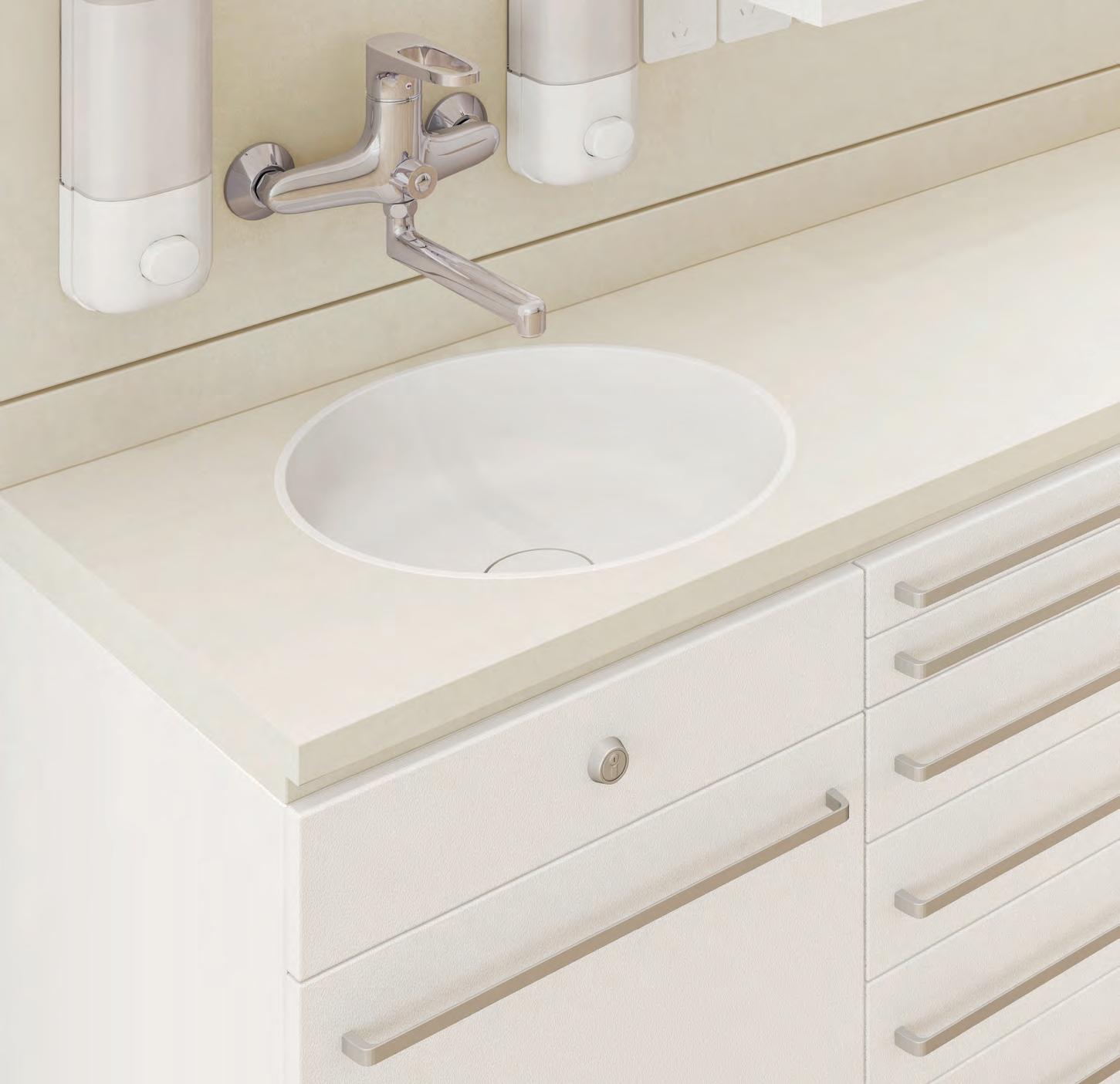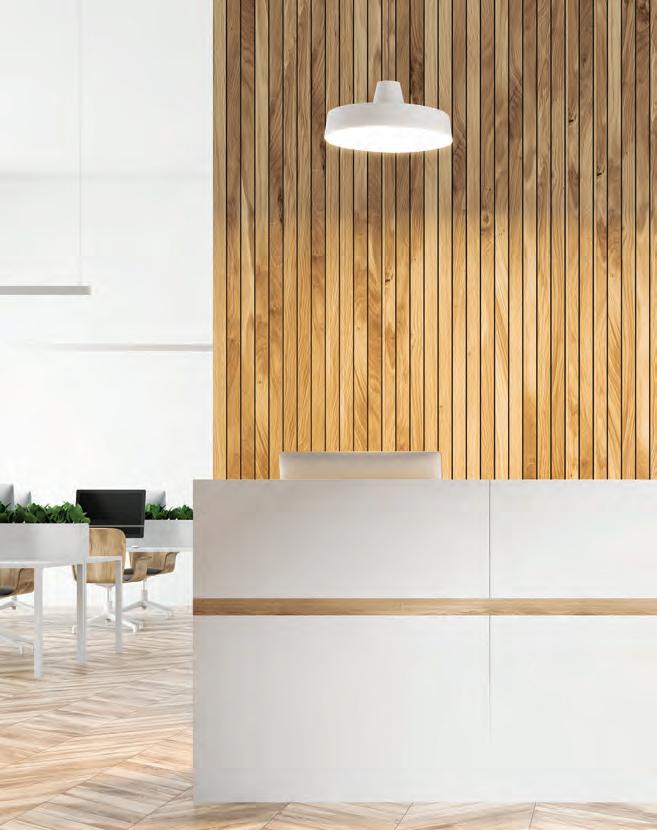
5 minute read
LAMINATES
WORDS STEPHANIE STEFANOVIC
As COVID-19 continues to surge throughout our nation – including new, more infectious strains of the virus – it really highlights the importance of health and safety measures in our buildings. And of course this goes far beyond QR codes and social distancing, extending to design factors such as floorplans, ventilation and even interior materials and fixtures. Perhaps nowhere is this more important than in health and aged care facilities, where occupants are vulnerable and immunocompromised, and any transmission of disease could be disastrous.

ABOVE Image from Nover.
Laminates and surfaces are a great example of interior materials and fixtures that have been refined over time to prevent the spread of disease in healthcare and aged care environments. This article will discuss a few of the most innovative products in this area, their key features and what makes these features so important in a healthcare or aged care application.
ACRYLIC SURFACES
Simple, versatile and perfect to add a pop of colour or shine to what might otherwise be a bland and sterile environment, acrylic surfaces are a good choice for interiors in a healthcare or aged care application. And if they can be made without harmful substances like silica, that’s even better.
One such example is Nover’s Evostone, a silica-free acrylic solid surface designed to resemble natural stone. Suited for use in kitchens and bathrooms, this product is hygienic, durable, waterproof and easy to clean, according to Nover. Stains and scratches can also be easily removed with daily cleaning, and importantly, harmful germs are unable to penetrate the non-porous (chipboard-free) panel.
The fact that this product is hygienic and easy to clean made it an ideal choice for a commercial dentistry in Melbourne, for example, where it was used as a surface in the practice’s working spaces. The inclusion of the Evostone surfaces managed to fit the understated design needs of the typical dentist’s office, while adding functional and healthy design to the space – essential characteristics of a busy medical facility.
Also by Nover, the Fenix NTM panels are well-suited for use in aged care facilities, according to the company. Made with nanotech anti-fingerprint technology, the panels can be used in both vertical and horizontal applications. The panels also contain acrylic resins which are hardened by an electron beam curing – creating a tough, durable surface with thermal healing capabilities and a low-glare matte finish. As an added benefit, they are hygienic, food-safe and easy to maintain with daily cleaning.
If microbes are a concern – which they should be, especially in high-traffic areas such as kitchens and bathrooms – another good option is ForestOne’s Meganite acrylic solid surface. For example, the brand’s latest range, AcryMed, is an advanced antimicrobial solid surface material specifically designed for use in healthcare environments. As the product has antimicrobial protection integrated into the solid surface sheet during production, the product is safeguarded against stain and odour causing bacteria. This makes it ideal for heavily frequented areas that can quickly become dirty, discoloured and unhygienic. According to ForestOne, what separates this product from other similar surfaces on the market is its effectiveness against the following bacteria: ATCC 33591 Staphylococcus aureus subsp. Aureus (MRSA), ATCC 8739 Escherichia coli, ATCC 9027 Pseudomonas aeruginosa and ATCC 4352 Klebsiella pneumoniae. The surface’s inconspicuous seams also make it a durable, grout-free option that is easy to clean and maintain.
STONE SURFACES
Always a sophisticated, luxurious choice, stone surfaces can be well-suited to use in healthcare and aged care applications, provided they have the right specifications. For example, Rocks On’s Protect line of porcelain stoneware tiles and slabs have an antimicrobial shield built into the porcelain body, designed to eliminate 99.9% of bacteria on the surface. This is achieved through the use of silver throughout the product – something often found in medical applications from wound dressings and creams to coatings on medical devices such as catheters.
How this works in the Protect line is that silver is integrated permanently into the porcelain tiles and slabs during the industrial firing phase at over 1,200°C, making it constantly active throughout the life cycle of the product. As a result, when bacteria come into contact with the surface, their metabolism
is blocked, interrupting the life cycle of the bacteria and its ability to spread. This makes it another good choice for healthcare and aged care applications, particularly where the design brief calls for healthy surfaces without compromising aesthetics.
LAMINATES
Laminates are another popular choice for healthcare and aged care applications, as they can be cost-effective while offering a vast range of finishes. As seen in the acrylic and stone products mentioned above, some laminates even include antibacterial properties, making them an appropriate choice for environments where hygiene is of the utmost importance.
One such example of this ForestOne’s Egger range of laminate and panels, with finishes including timber reproductions and matte anti-fingerprint properties. Designed with sustainability at the forefront, Egger’s worktop range is made from 59 percent recycled materials, including post-consumer waste. And according to ForestOne, unlike other similar materials, the Egger range of laminate and panels comes with antibacterial properties as a standard, rather than an expensive add-on.
A good illustration of this product in use is the interior design of a doctor’s office in Fritzlar, Germany, where the Egger compact laminate in China Red was used to brighten up and improve the quality of the space, contrasted against the Egger chipboard and edging in white. According to ForestOne, the red compact laminate was used throughout the reception area, consultations and employee kitchen, with some of the key benefits being the material’s uniform structure and dirt resistance. This makes it not only an eye-catching addition to the space, but also a low-maintenance and highly functional material for its application. While antibacterial and antimicrobial surfaces (for example) are not a substitute for good health practices in our buildings, they can go a long way in preventing the spread of disease in high-traffic areas frequented by occupants who are already ill or vulnerable to disease. This is particularly important in healthcare and aged care applications, but it is worth noting that the COVID-19 pandemic has proved just how important it is to prioritise healthy design in all of our structures. Thankfully, innovations in materials and healthy design strategies are making this easier all the time, and many of the materials mentioned above are being used in a wide variety of applications from hospitality to education and even individual residences. This is certainly encouraging, and hopefully a sign of a bigger trend towards healthy design in Australian architecture.
SUPPLIERS ForestOne architectureanddesign.com.au/suppliers/forestone Nover architectureanddesign.com.au/suppliers/nover Rocks On architectureanddesign.com.au/suppliers/rocks-on-hard-surface-solutions
RIGHT Laminates and surfaces are a great example of interior materials and fixtures that have been refined over time to prevent the spread of disease in healthcare and aged care environments.











